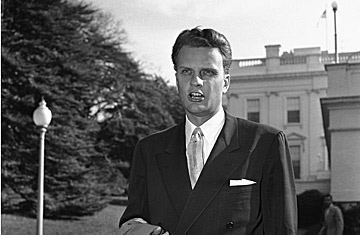
Evangelist Billy Graham leaves the White House
(5 of 10)
After winning two minor celebrities as converts (Cowboy Singer Stuart Hamblen and Track Star Louis Zamperini), Graham made the front pages by converting one "Big Jim" Vaus, a wiretapper by trade who had recently done a job or two for Gangster Mickey Cohen. The story got even better when Graham invited Cohen to a small meeting of Hollywood personalities. "When I asked for people who wanted prayer to hold up their hands," he remembers, "Mickey lifted his hand, and I am sincerely convinced that he wanted God."
This was the kind of thing newsmen could not ignore. All at once Billy was a national figure.
The Technology of Salvation. While Evangelist Graham sincerely considers himself nothing but a tool of God, he believes in giving God plenty of help with some tools of his own. The tools he has fashioned add up to an intricate technology of soul-saving that might astonish St. Paul, bewilder John Wesley and give any Madison Avenue adman some ideas.
Like Field Marshal Montgomery, Billy Graham never launches an attack unless he can be fairly sure in advance that his forces are superior to the enemy—the main enemy perhaps being indifference. Before Graham agrees to conduct a campaign in any given city, preliminary negotiations may go on for years (New Orleans churchmen first began talking about the current crusade in 1950). Graham must be sure that he has the backing of the top Protestant churches in the area, as well as the support of business and civic leaders. After he accepts an invitation, the local sponsoring committee is promptly presented with a "Graham Plan" for financing.
Two months before the campaign is scheduled to begin, the first member of the Graham team arrives in town. Willis Haymaker, 57, who worked as advance man for such old-school soul-savers as Gypsy Smith and Bob Jones but thinks Billy is the greatest of them all, mobilizes the preachers and laymen of the cooperating churches into a vast cadre of workers. From 1,000 to 3,000 are tapped for choir duty. Between 700 and 1,000 become "counselors," and about 1,500 be come ushers. Women are selected to staff the ticket office and switchboards. Deacons, Sunday school superintendents and other church workers are organized into "followup" classes, where they are taught how to bring new converts into local church life. Says Graham: "We have a fair audience ready before we even get there."
The town begins to sprout posters, street banners, window cards and bumper stickers announcing the impending crusade. Typical of the Graham team's meticulous know-how is the way its members tackled the matter of bumper stickers. First they tested the different methods of attaching a sign to a bumper—string, elastic, clips, hooks, adhesive. Having decided adhesive was most lasting, they began testing surfaces, determined on a kind called "Dayglo" which shines in sunlight or headlight. Dayglo comes in single, double and triple screen, hence more testing and the decision to use double. To find the best adhesive, lots of 25,000 were tested in various cities.
